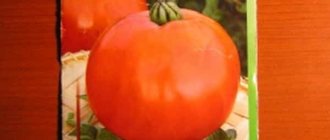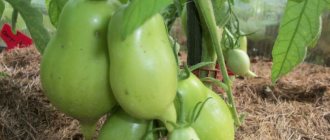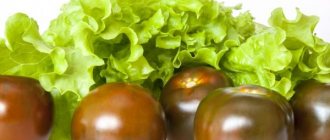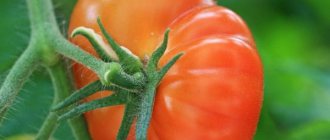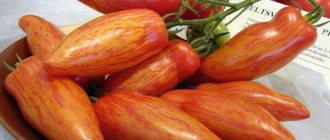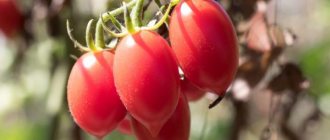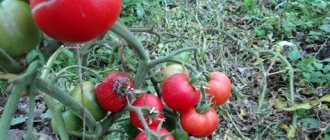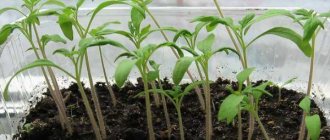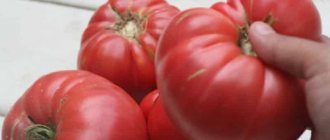History of the variety's creation
Hybrid Village F1 is presented by Agro, which is the originator of the variety and also distributes the seed material of this tomato. The Village tomato was created in 2021; breeders worked on its breeding for 3 years.
The variety is recommended for cultivation in open ground in the southern regions of Russia,
since it is thermophilic. In other regions, it is recommended to grow it in film greenhouses or greenhouses.
Photo of the hybrid Village F1
The nuances of breeding in open ground and in a greenhouse
The variety is interesting because it can be grown in seedlings and without seedlings. In the second case, fruiting will occur a little later, but nevertheless, the seedless method is a big plus for the southern regions. Many gardeners sow seeds directly into open ground or under film, which does not in any way affect the quality and quantity of fruits.
Greenhouse plants exceed the growth stated by the manufacturer and sometimes reach 1 m. To prevent plants from wasting nutrients on the growth of unnecessary branches, the top of the head is pinched, thereby determining the growth point.
Closed structures are ventilated daily. An influx of fresh air is necessary for the full development of seedlings, and it also destroys the usual habitat of some pests.
Main characteristics and description of the variety
The tomato hybrid Village belongs to the determinate type,
therefore, the growth of its shoots is limited - a racemose inflorescence is formed at the top of the central stem, limiting further upward development.
The height of the erect central shoot is up to 1.4-1.5 m, the bushes are powerful and strong, the shoots grow the same way, since they must withstand the weight of the ripening harvest. The stems are well leafy, the foliage is medium in size, typical tomato shape, dark emerald in color.
Tomato Village F1 requires mandatory formation of bushes and mandatory gartering of stems.
Usually, when growing a Village tomato hybrid, it is formed into 2-3 shoots. This variety needs a garter, since a large number of fruits ripen on the bush at the same time, under the weight of which even thick and powerful shoots can break.
The Village tomato is classified as a late-ripening variety - from the moment of germination of the seed material to the harvest of ripe fruits, 3-3.5 months pass
. This tomato is planted in open ground in the southern regions of Russia, and in colder regions it is better to plant Derevensky tomato seedlings in film greenhouses or a greenhouse, since the hybrid does not tolerate cool weather well.
Important!
The Village tomato variety is classified as beef tomatoes, which means large-fruited.
The first inflorescences are formed after the 6th true leaf, the next ones - every 2-3 leaves. The inflorescences are racemose, and more than 7 ovaries can form in each raceme.
Tomatoes of this variety are flat-round in shape; the weight of the Derevensky tomato fruit can range from 300 to 600 g
. But the first tomatoes, with good care, can weigh up to 1 kg. The color of ripe tomatoes is original, orange with a yellow tint; thin red stripes extend from the base across the entire surface of the fruit.
Village Tomato. Compact and very productive variety - video
Derevensky fruits are fleshy with an excellent taste - sweet with a slight sourness.
. And the aroma of ripe tomatoes contains fruity notes. The number of seed chambers in the fruit is no more than 5. The color of the ripe pulp is orange.
Fleshy, tasty tomatoes are used to make salads and make delicious tomato juice or paste. But they are not used entirely in preparations due to the large size of the fruits. Many housewives preserve tomatoes of this variety in pieces with onions.
Disease-resistant tomato varieties
The fruits are quite dense with strong, smooth skin, so they tolerate transportation well at different distances, and can be stored in the refrigerator for up to 2 weeks without losing their presentation and taste.
Planting dates and care features
The Village tomato has a long growing season. In order for the first fruits to begin to ripen in mid-summer, seeds for seedlings should be sown at the end of February. At this time of year, daylight hours are still short, young seedlings require additional illumination with phytolamps or fluorescent lamps.
Seedlings ready for planting in the greenhouse should be stocky and have 6-7 true leaves of a dark green color.
High-quality seedlings are obtained by hardening tomatoes for two weeks with a gradual increase in the time spent on the balcony or in the greenhouse.
Features of agricultural technology:
- The variety is powerful, but not spreading, per 1 sq. m plant 4-5 plants. The highest yield is achieved when a tomato is formed into 2-3 trunks.
- After planting, the seedlings are immediately tied to a trellis or a strong stake is stuck in, which can withstand the weight of a bountiful harvest.
- The first feeding is carried out 14 days after planting in the ground. Ammonium nitrate is applied in an amount of 35 g per bush. Further fertilizing is carried out every 2 weeks with fertilizers containing phosphorus and potassium.
- Village tomatoes cannot tolerate drying out of the top layer of soil; excessive waterlogging can lead to cracking of the fruit. The crop needs normal watering every 3-4 days with warm, settled water.
- Tomatoes are regularly weeded and surface loosened, avoiding damage to the root system. Mulching tomatoes solves the problem of weed growth and keeps the soil surface moist.
- The Village variety needs regular pinching. The thickening of the bush leads to a decrease in yield and provokes the development of diseases.
Important! Not only the stems, but also the tomato brushes need a garter. The load on each bunch is more than 1.5 kg; the brushes can break off under the weight of the harvest.
Tomato yield
This variety is characterized by high productivity - usually 40-45 large fruits are formed on each bush, as a result, at least 5.5-6.5 kg of ripe products are collected from each bush
. And on each square of area it is recommended to plant up to 4 bushes of Village tomatoes. Therefore, the yield of the variety per 1 m2 is considered high.
VERY LARGE TOMATO! VILLAGE F1 – video
But vegetable growers usually achieve such yields if they follow all the rules for caring for this hybrid.
Tomato parameters
This variety ripens quite late. 125-140 days pass from the emergence of seeds. Tomatoes definitely require pinching and staking, as the vegetable is tall. The plants reach a height of about 1.5–2 meters. It is recommended to plant it so that 2-3 stems are formed. The trunk of the plant is strong, there is a lot of foliage on it.
Its shape resembles a steak. In the usual case, the weight of the fruit reaches 300-600 grams, but there are exceptions where the tomato fruit can reach up to 900 grams. The color is bright and expressive, attracting the eye. These are various shades of red, yellow and orange. The skin of the tomato is not hard, inside it is soft, tasty and there are few seeds.
Diseases and pests
The Derevensky tomato hybrid has good resistance to most diseases characteristic of other varieties of nightshade crops. However, resistance to late blight and spotting is below average. Therefore, experts recommend treating the soil with fungicidal preparations before planting the Derevensky hybrid.
Bushes should be treated with solutions of the following products:
- Ridomilom Gold;
- Fitosporin;
- Quadris.
Advantages of the variety
The main positive qualities of the Derevensky hybrid include:
- ripe fruits are large and fleshy, perfect for making and preserving tomato juice, paste and sauces;
- fruiting is stable;
- high yield per 1 m2;
- wonderful taste of ripe tomatoes;
- the skin is dense and strong, so the harvested crop tolerates transportation well, the fruits are not prone to cracking, and do not leak during transportation;
- resistance to a number of diseases is high.
Photo of a Village tomato in section
Among the disadvantages of the Derevensky variety, it should be noted:
- this hybrid requires appropriate care - compliance with the irrigation regime, regular fertilizing, constant removal of stepsons;
- you need to monitor the soil moisture; if it is high, the tomatoes will begin to crack;
- Whole-fruit canning of fruits is impossible due to their large size.
Characteristics of the variety
The characteristics and description of the variety are as follows:
- Mid-season, high-yielding tomato.
- The bush is indeterminate; when grown, it requires the formation and removal of excess shoots.
- Brought out in Russia for planting mainly in closed ground.
- The plant reaches a height of 150 centimeters.
When forming a bush, the first stepson is formed in the axil of the 9th leaf, the subsequent ones - after 3 leaves. A plant with powerful branches and large fruits. The growing season is from 110 to 120 days. The harvest begins in June and ends in September.
The fruits are medium and large, weighing 150–180 grams; individual tomatoes weigh up to 400 grams.
Slavic masterpiece description:
- a medium-sized vegetable is smooth, round, slightly flattened;
- large fruits have weak ribbing;
- the color of unripe tomatoes is green with a dark spot near the stalk, ripe ones are red;
- the taste is bright, sweet with sourness;
- bred for fresh consumption.
Agricultural technology for growing tomato Village
Usually this variety is grown by seedlings. In this case, it is possible to obtain a harvest earlier than the period indicated in the description of the hybrid.
Also, vegetable growers in regions with a short summer period are engaged in growing the Derevensky tomato through seedlings, so that the entire crop has time to ripen before the onset of cold weather.
Agricultural technology for growing tomatoes - video
Planting seedlings
You can plant seed material in containers - low, but wide and long enough, or a couple of seeds at once in separate cups to avoid picking in the future. If planting containers are used for growing seedlings annually, they should be disinfected with a weak solution of potassium permanganate before planting.
Soil for planting Rustic tomatoes can be purchased at a specialized store for growing vegetable seedlings, or you can prepare it yourself. To do this, take an equal amount of garden soil, humus and compost, add wood ash, and mix everything thoroughly. To disinfect soil prepared at home, you need to spill it with a weak solution of potassium permanganate.
Important!
Since this tomato is a hybrid, it is useless to collect seed material from plants, since the grown plants will not have parental qualities. Therefore, for planting, you will have to purchase seeds annually from specialized stores.
Pre-sowing preparation of seeds purchased in a store is carried out by the manufacturer, so before planting the seed, it is enough to soak it for faster germination.
The prepared soil is laid out in containers, moistened and grooves 1.5 cm deep are made at a distance of 3.5 cm from each other.
It is advisable to place the seeds in furrows at a distance of 2.5 cm from each other. After planting, the containers are covered with polyethylene and placed in warm, bright rooms for germination.
Before seed germination, containers should be periodically ventilated and the soil should be moistened with a spray bottle.
After the emergence of seedlings, the polyethylene is removed, and the containers are transferred to a bright room with an air temperature of about 15-17 degrees Celsius for two days.
The soil in the containers must be constantly moist, otherwise the tomato roots will develop more slowly.
Picking tomato seedlings
Picking seedlings of this tomato is carried out only if it was planted in large containers. Tomato seedlings are ready for this procedure when at least 2 true leaves appear on them. In this case, weak seedlings are removed.
The seedlings are planted in separate containers; the composition of the soil in the cups should be the same as in the containers. When transplanting, seedlings should be buried down to the cotyledon leaves.
Transplantation to a permanent place
About a couple of weeks before transplanting the Derevensky tomato seedlings to a permanent place, you should begin to harden them. To do this, containers with seedlings are taken out into the fresh air - at first for a short time, but gradually increasing the time the plants stay outside.
It is necessary to transplant healthy seedlings into garden beds when the threat of return spring frosts has passed.
The beds for planting Derevensky tomatoes are prepared in advance: they are dug up, organic fertilizers and wood ash are added.
No more than 4 plants should be planted on each square of area. Immediately after planting, the seedlings should be watered.
Excellent varieties of tomatoes!
Tomato Irishka F1 Tomato Korolevich Tomato Lady fingers
A royal harvest of tomatoes is the best gift for a gardener. Find out how to make it
New Years is soon! The most beloved, long-awaited, elegant, beautiful and kindest holiday! Only at this wonderful moment does Santa Claus come
And it doesn’t matter at all whether you believe in fairy tales or not, he will give gifts to everyone without exception. And you and I have very little time left to “help” Santa Claus and stock up on surprises for our loved ones
Attention is the most important thing. What is the best present for a gardener? Something gardening, of course!
Tomato 'Country F1'
It is rare that a modern domestic gardener denies himself the pleasure of growing large-fruited salad tomatoes. Therefore, you will definitely like this gift. We invite you to purchase seeds of three new hybrids 'Village F1', 'Castellano F1' and 'Queen F1' for testing. Their fruits are tasty, large, beautiful, and at the same time the plants are resistant to diseases. Now I will be pleased to briefly introduce these new products to you.
'Village F1' - mid-early determinate
The first New Year's "gift" is a mid-early determinate hybrid 'Village F1'. From germination to the first ripe fruit - approximately 110 days. The plant is compact, low, and the yield is excellent. An average of 45 fruits ripen on one bush! All large, leveled, average weight 300 g, picked 3 pieces - and already a kilogram! The fruits are flat-round, bright red in color. The seed chambers are small - you cut a tomato, and inside there is solid juicy pulp. Therefore, the hybrid 'Village F1' belongs to the beef tomato type, a sort of “meat tomato”.
Mid-early determinate hybrid 'Village F1'
“Beefs” became in demand with the advent of fashion for hamburgers, which require a large-diameter tomato slice with dense pulp, like a ripe persimmon. The taste of the fruit is sweet, the acid is not felt at all. We tested this hybrid in our experimental farm and recommend placing 5 plants per 1 m², and forming them into 2-3 stems. In this case, the harvest is as good as possible, there are a lot of fruits, all large. This concludes my brief introduction to this tomato, but I recommend taking a closer look at this wonderful new product in our video Very large tomato 'Country F1'.
'Castellano F1' - high-yielding indet
Another beef tomato is the indeterminate hybrid 'Castellano F1'. Its growth is unlimited and it bears fruit for a long time. In a greenhouse it produces an excellent harvest - over 25 kg per 1 m². Ripe fruits are rich bright red in color, flat-round and slightly ribbed, beautiful in cross-section. The pulp is also dense, “meaty”. Fruit weight is 250-325 g, the taste is excellent.
High-yielding 'Castellano F1'
It has been experimentally verified: it is best to form this hybrid into 1 stem, then the fruits will be equal in size. It is advisable to plant 3-3.5 plants per 1 m² of bed
It is important that the hybrid 'Castellano F1' turned out to be particularly resistant to the leaf curl virus and tomato bronzing. Watch our video about this tomato
You will see what powerful plants laden with fruits have grown in our greenhouse.
'Queen F1' - mid-season non-sick indet
And our third today's “hero” is the hybrid 'Queen F1'. This name was not invented just like that. A tomato truly with royal virtues. This indeterminate mid-season hybrid is a beef tomato type and is incredibly disease resistant! At the same time, the color of its fruits is a very rich pink, almost crimson color.
Indeterminate mid-season hybrid 'Queen F1'
The fruits are large, average weight 300 g. The taste is absolutely impeccable - sweet, juicy, meaty. They are stored for a long time. We recommend eating it fresh, the “queen” is too good! Grow in protected soil, plant 3 plants per 1 m², form into 1 stem, and then the yield will be over 25 kg/m². We also did not ignore the “Queen” and shot a video where you can see all the beauty of this hybrid.
Prepare fertile, light, nutritious soil for tomatoes. Don’t be greedy, add 2, or better yet 3 buckets of biohumus per 1 m² of bed, form the plants correctly, water them on time, and you will have royal harvests.
Come to us for seeds and New Year's gifts. And happy New Year, it’s already very close!
Vasily Ivanovich Blokin-Mechtalin, general director of agro
Further care for the Village tomato
Caring for the Derevensky hybrid bushes is no different from caring for other varieties of tomatoes: maintaining the watering regime, loosening the soil and regular fertilizing.
TOMATO CARE. First IMPORTANT steps - video
Important!
Watering is carried out as the soil dries, the main thing is to prevent stagnation of moisture in the soil. Excessive watering is especially dangerous during the ripening period of fruits - they can crack due to the high moisture content in the soil.
After each watering, it is recommended to loosen the tree trunk circles, while simultaneously removing weeds.
Growing
In order to get a bountiful harvest from a Derevensky tomato bush, you must adhere to a certain growing technology. This approach will ensure good fruiting.
Growing seedlings
Before the planting process, the seeds must first be prepared. They are soaked in a 1% solution of potassium permanganate. For 100 ml of water, 1 g of the drug is required. Afterwards, the planting material is placed in a container with a solution, where it remains for 20 minutes. Next, the seeds are dried and planted as seedlings.
Village tomato seedlings are usually obtained in a greenhouse. In this case, the daytime temperature should be about + 23 °C, and at night - not lower than + 17 °C. The soil should be soft and sufficiently loosened.
The seeds themselves are placed 1-2 cm deep inside the soil, and sprinkled with a layer of soil of approximately 5 ml on top.
Landing rules
Seedlings are usually transplanted 60-65 days after the first shoots appear. Before planting, the soil is fertilized with humus or wood ash. Next, holes are formed for the plants. They should be of a size that will allow the entire root system of the tomato to be placed there without damage. They should also be watered generously.
Watering and fertilizing
Immediately after planting, it is better not to water the Derevensky variety for 5-10 days. After this period, it is necessary to moisten the soil at least twice a week (as the land area dries out, more often). The amount of water is calculated approximately according to the scheme 3-5 liters per bush.
In order for tomatoes to grow and develop evenly, it is necessary to monitor the saturation of nutrients in the soil. To do this, you need to regularly feed the tomatoes.
In the initial stage of development, phosphorus plays a special role. At the moment when fruit formation begins in Derevensky, potassium is added along with phosphorus. It promotes flowering, fruit formation and ripening, and also increases disease resistance. Also, for feeding in a later period, nitrogen fertilizers are applied.
Pinching and tying
Since the rustic variety belongs to the category of tall tomatoes, it needs to be tied up in a timely manner. At the same time, it is important to ensure that during the process the stem is not touched and no constrictions are formed on it, which could break the bush.
Stepchildren are removed so that the plant does not expend excess energy on their growth. This promotes larger fruiting.
Formation
The bush is usually formed into 2-3 branches. For these purposes, during stepsoning, 1-2 of the strongest stepsons are left. During gartering, they are also fixed, and then they are harvested in the same quantity as from the main stem.
Protection from diseases and pests
Before planting the seedlings, it is recommended to treat them with systemic fungicides. The most commonly used are the following:
This procedure will help protect young shrubs during a period when they are especially susceptible to diseases and pests.
The Village tomato is especially susceptible to diseases such as stolbur or phytoplasmosis. The leaves of the affected bush begin to shrink, the plant itself lags behind in growth, and the flower petals grow together, forming something like a corolla.
The most effective way to combat the disease is to destroy the affected tomatoes. This is the only way to stop the development of the disease and protect the remaining bushes.
Among the pests of the Derevensky variety, the most common are cicadas, moths and aphids. If they are detected, you need to treat the area with pesticides for some time.
Feeding tomatoes
A couple of weeks after transplanting the seedlings to a permanent place, you should feed this vegetable crop with saltpeter. In this case, no more than 90-95 g of the drug should be applied to each square of area.
During the summer season, this hybrid is fed with organic matter - greenfinch solution, mullein. The last feeding is carried out before the end of fruit ripening.
Important!
All fertilizing for tomatoes is carried out after watering.
Feeding tomatoes!
How to fertilize tomato seedlings and bushes after transplantation and during fruiting period
Growing seedlings
When choosing seeds, it is important to pay attention to the company that produced them.
To grow strong seedlings of Derevensky tomato, you need to first soak the seeds in a weak solution of potassium permanganate. For 1 liter of water you will need 2 g of the substance.
Keep the seeds in the mixture for no more than 30 minutes, then rinse them under running water at room temperature.
Sow them in the prepared soil to a depth of no more than 1 cm. Pre-moisten the soil. Gently water the crops with a small amount of water. As the soil dries, spray it.
If tomatoes are grown in protected soil, the temperature must be maintained at least 24 °C. At home, you can use film. When sowing seeds directly into a greenhouse, the temperature should be at least 20 °C.
Seedlings grow no more than 2 months. When the third pair of leaves appears, the seedlings can be planted in the greenhouse.
():
Since the variety is late-ripening, sowing seeds for seedlings should begin as early as February in order to receive fruits not at the end of summer, but earlier. But when growing seedlings early, they will definitely have to be illuminated with a lamp, because in February the days are still short.
Tomato Village F1: reviews from those who grew
Olga, 50 years old, Volgograd region: In my garden, I plant most of the beds with different varieties of tomatoes. I plant the Village hybrid specifically for further processing - I prepare tomato juice, lecho and tomato paste for the winter. The yield of this variety is high, so I have enough of these preparations for the whole winter.
Elena, 48 years old, Chelyabinsk region: In our region the climate is unpredictable, so I grow all vegetable crops only in greenhouses and greenhouses. I regularly plant at least one bed with a new variety of tomatoes. Last season I planted a new product - the Derevensky tomato hybrid. I liked the variety - the care is the same as for other varieties, you just need to carefully water it and fertilize it regularly (at least once every couple of weeks). The variety has a high yield - I collect up to 25 kg of ripe fruits from one square. My family members really like these tomatoes in salads, as well as in preparations - I prepare delicious lecho and sauces for the winter.
The Village tomato hybrid is one of the most productive late-ripening tomato varieties.
The harvested crop tolerates transportation well over any distance and can be used fresh for food. And also prepare tomato juice, paste or sauces.
Reviews
Petr Alekseevich:
“I have a plot of land in a small village. In hot weather (summer) I love digging in my garden. I like to grow various vegetable crops. This season I decided to try the Village tomato variety. I did not regret my choice, the seedlings grew well, but after replanting the tomatoes could not take root in the soil for a long time. They reached a height of up to 1.5 meters. The harvest was small, but the fruit itself was large and its pulp was very tasty. In general, the variety is excellent, but in the future I would like to get more harvests.”
Galina Fedotovna:
“I prefer that the tomato fruits are large. You can make delicious tomato juice from these. The village tomatoes were good both in size and taste. For such a tall variety, the plant produces an average harvest. I grew them in greenhouse conditions and did not water them often. Unfortunately, the tomato fruits showed small cracks.”
